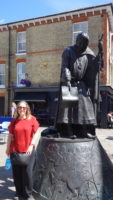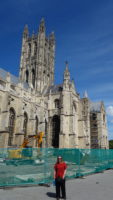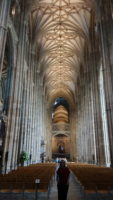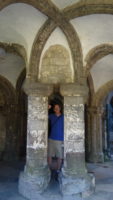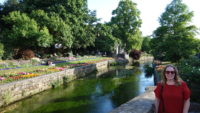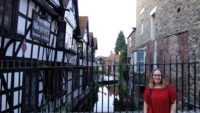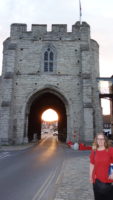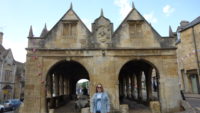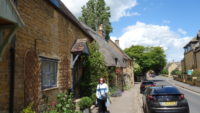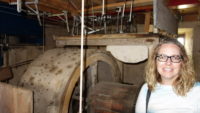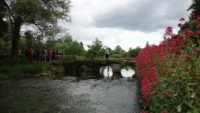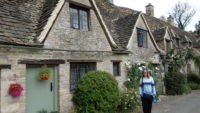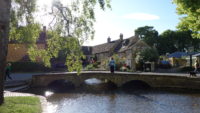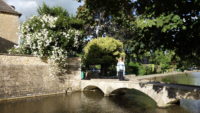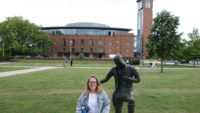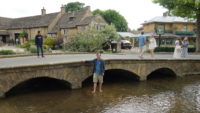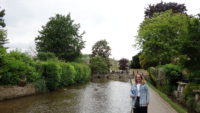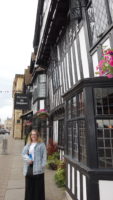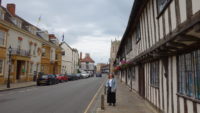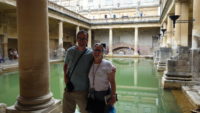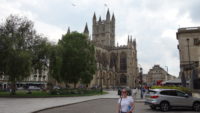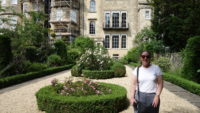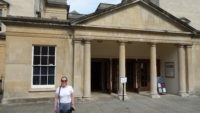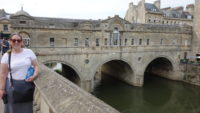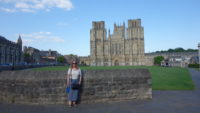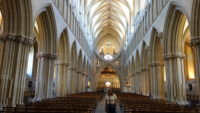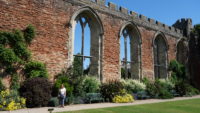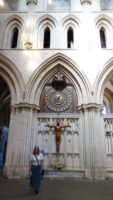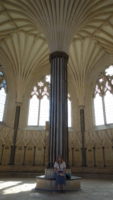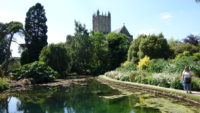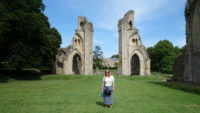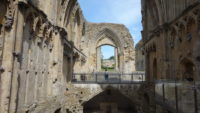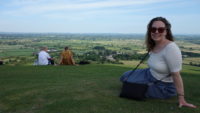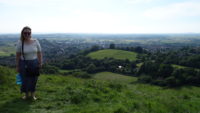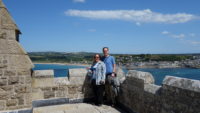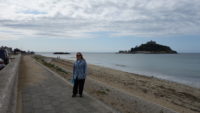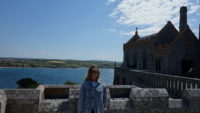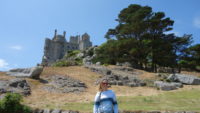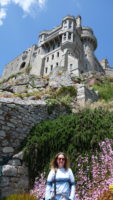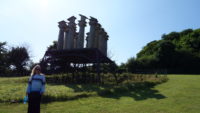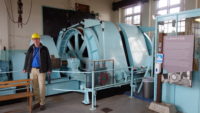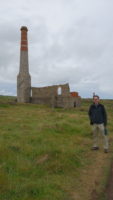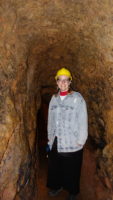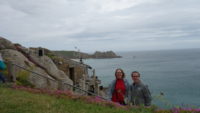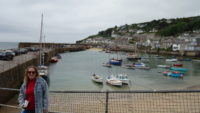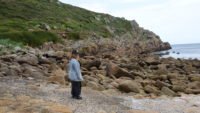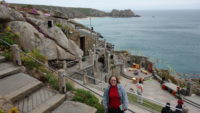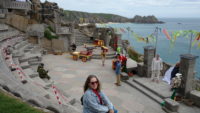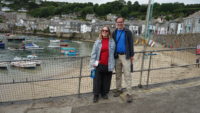 “All Kent hath yielded; nothing there holds out / But Dover castle: London hath received, / Like a kind host, the Dauphin and his powers.” – Philip the Bastard to King John in King John (Shakespeare)
“All Kent hath yielded; nothing there holds out / But Dover castle: London hath received, / Like a kind host, the Dauphin and his powers.” – Philip the Bastard to King John in King John (Shakespeare)
One of the great things about travel in England is that in most places we go, something important happened there. Today, that somewhere was Dover Castle. Dover Castle was built (at least the central tower was built) by King Henry II starting in the 1180s, and the castle has been added on to and used for different purposes ever since. The castle was never taken by any attackers, so the tower is still the original one that Henry II built. Shakespeare’s play deals with Henry’s son, who lost much of the huge France/England/Wales/Ireland empire that dad had inherited or conquered. King John is also famous for ticking off his barons enough that they forced the Magna Carta on him.
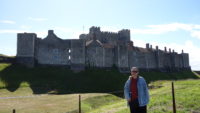 At any rate, Dover Castle was Henry’s showpiece. It is huge, and the number thrown at us today was it cost about seven billion of today’s pounds ($8.6 billion) to build it, although comparisons of money across such a vast amount of time are notoriously bad. Since many pilgrims came through Dover on the way to Canterbury to see the shine of Thomas Becket, Henry wanted a PR piece to help smooth over his own part in having had Becket killed. The tower clearly stated who had the money and power in the region.
At any rate, Dover Castle was Henry’s showpiece. It is huge, and the number thrown at us today was it cost about seven billion of today’s pounds ($8.6 billion) to build it, although comparisons of money across such a vast amount of time are notoriously bad. Since many pilgrims came through Dover on the way to Canterbury to see the shine of Thomas Becket, Henry wanted a PR piece to help smooth over his own part in having had Becket killed. The tower clearly stated who had the money and power in the region.
Since Henry’s time, the castle and grounds have been used to prepare against possible invasion by Napoleon, as a watch post and Royal Navy harbor during WW I, as the headquarters of the Royal Navy during WW II, and as a Cold War bunker through the early 1980s. The grounds of the castle are huge; there is much to see. We spent six hours there today.
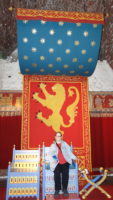 We started with a guided tour of the underground WW II tunnels, used as the navy’s headquarters. The tunnels had been carved as barracks for men during Napoleon’s time, and the navy moved into them. They called out of retirement Admiral Ramsey, who masterminded Operation Dynamo, coming up with the entre thing in about one week. Dynamo was the plan to extract 45,000 British troops (of about 140,000) who were trapped on the beaches of Dunkirk. The admiralty didn’t think it possible to get more troops out. In the end, by using even fishing ships and yachts, 338,000 men of the British Army and their allies were rescued over eight days. It was a huge and unexpected success. To follow that up, Ramsey also coordinated other navy operations in the Mediterranean and ran all the navy operations for D-Day. He was a remarkable man. Sadly, he died in a plane crash in 1945 before the end of the war.
We started with a guided tour of the underground WW II tunnels, used as the navy’s headquarters. The tunnels had been carved as barracks for men during Napoleon’s time, and the navy moved into them. They called out of retirement Admiral Ramsey, who masterminded Operation Dynamo, coming up with the entre thing in about one week. Dynamo was the plan to extract 45,000 British troops (of about 140,000) who were trapped on the beaches of Dunkirk. The admiralty didn’t think it possible to get more troops out. In the end, by using even fishing ships and yachts, 338,000 men of the British Army and their allies were rescued over eight days. It was a huge and unexpected success. To follow that up, Ramsey also coordinated other navy operations in the Mediterranean and ran all the navy operations for D-Day. He was a remarkable man. Sadly, he died in a plane crash in 1945 before the end of the war.
We took the other guided tour offered, which was to tour the underground hospital, which was ultimately used as a dressing station. We “followed” (on audio speakers) a wounded pilot though the admission process, prep, and surgery, while the lights flickered on and off during an air raid. It was a much shorter tour, but gave a good overview of the difficulties of treating wounded underground; it’s hard to operate with little or no lighting, and space was cramped.
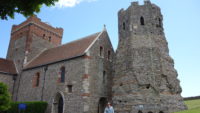 After that, we were free to wander around. We checked out the WW 1 watch post, which included a high platform for flag signals, as well as a bunker for telegraph operators. The men here watched the Channel for any boat and identified if it was a friend or foe. Since you can see France on a clear day (like today), it would have been hard for ships to hide from binoculars. The Channel is only twenty-three miles wide here.
After that, we were free to wander around. We checked out the WW 1 watch post, which included a high platform for flag signals, as well as a bunker for telegraph operators. The men here watched the Channel for any boat and identified if it was a friend or foe. Since you can see France on a clear day (like today), it would have been hard for ships to hide from binoculars. The Channel is only twenty-three miles wide here.
The castle map had numbered buildings, so I decided to follow them more or less in order. The first stop was a Roman lighthouse from the first century that is still mostly intact (a top layer was added as a bell tower for the circa 1000 church). The church right next to it is still open for services, although they have blocked up the “Saxon door” without any commentary as to why.
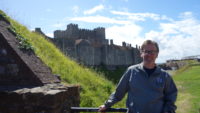 After that was the magnificent Great Tower and surrounding walls. When I thought of castles when I was a kid, the pictures in my head matched this castle. It is giant and blocky and intact. The Tower has been restored inside to how it probably looked, based on manuscript pictures and descriptions. The layout was fairly simple – three main levels split in two – the kitchens, the guest sleeping areas and banqueting hall, and then the king’s bedroom and chambers. You could also go up on the roof, which had great views.
After that was the magnificent Great Tower and surrounding walls. When I thought of castles when I was a kid, the pictures in my head matched this castle. It is giant and blocky and intact. The Tower has been restored inside to how it probably looked, based on manuscript pictures and descriptions. The layout was fairly simple – three main levels split in two – the kitchens, the guest sleeping areas and banqueting hall, and then the king’s bedroom and chambers. You could also go up on the roof, which had great views.
After a quick lunch, we explored the medieval tunnels. I think these were to help move men around while under cover, but there was no information given. The tunnels were outside the Tower and first walls, but were inside the second set of walls overlooking the moat between the walls. It doesn’t surprised me that the castle was never taken – it was defended to the teeth.
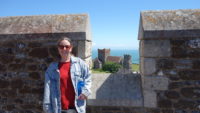 After the tunnels, we went up on the embankment and outer walls, where there were cannons from the nineteenth century next to anti-aircraft guns from the 1940s. There were also spectacular views of the inner walls and tower.
After the tunnels, we went up on the embankment and outer walls, where there were cannons from the nineteenth century next to anti-aircraft guns from the 1940s. There were also spectacular views of the inner walls and tower.
That took up our six hours, and so we wended our way back to Canterbury. We got a light supper at a bakery, and then went to the walled part of the city, where we walked through a small park, and then ambled along the High Street further than we had yesterday. We had some happy views of the cathedral down small alleys of old shops.
 And so we wrapped up this tour of southern England. We couldn’t have asked for better weather – we only had about forty-five minutes of real rain when were were trying to tour, and that was over fifteen days. England hath received, like a kind host, Meredith and her tourer. A jolly good trip for us.
And so we wrapped up this tour of southern England. We couldn’t have asked for better weather – we only had about forty-five minutes of real rain when were were trying to tour, and that was over fifteen days. England hath received, like a kind host, Meredith and her tourer. A jolly good trip for us.
